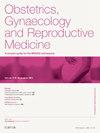Benign ovarian cysts in premenopausal women
Q3 Medicine
Obstetrics, Gynaecology and Reproductive Medicine
Pub Date : 2025-01-01
DOI:10.1016/j.ogrm.2024.10.003
引用次数: 0
Abstract
Benign ovarian cysts are a common gynaecological presentation. Up to 10% of women will have surgery for an ovarian cyst in their lifetime. When an adnexal mass is diagnosed, the differential diagnosis is wide and up to 10% may be non-ovarian in origin. The goal of management is to determine the underlying pathology and to risk stratify patients to guide further management. Transvaginal ultrasound scanning remains the imaging modality of choice and the use of simple rules as well as benign and malignant features should form the basis for diagnosis, with serum markers used as an adjunct. Cross-sectional imaging with other modalities including magnetic resonance imaging are useful in the management of indeterminate masses. Most ovarian cysts are benign in nature and most functional and simple cysts are likely to resolve spontaneously without intervention. This review will demonstrate four clinical scenarios with different underlying pathology and their management.
绝经前妇女良性卵巢囊肿
良性卵巢囊肿是一种常见的妇科表现。多达10%的女性一生中会因卵巢囊肿接受手术治疗。当诊断出附件肿块时,鉴别诊断范围很广,高达10%可能是非卵巢起源的。管理的目标是确定潜在的病理和患者的风险分层,以指导进一步的管理。经阴道超声扫描仍然是首选的成像方式,使用简单的规则以及良性和恶性特征应构成诊断的基础,血清标志物用作辅助。包括磁共振成像在内的其他方式的横断成像在不确定肿块的处理中是有用的。大多数卵巢囊肿本质上是良性的,大多数功能性和单纯性囊肿很可能在没有干预的情况下自行消退。这篇综述将展示四种具有不同基础病理的临床情况及其处理。
本文章由计算机程序翻译,如有差异,请以英文原文为准。
求助全文
约1分钟内获得全文
求助全文
来源期刊

Obstetrics, Gynaecology and Reproductive Medicine
Medicine-Obstetrics and Gynecology
CiteScore
0.90
自引率
0.00%
发文量
67
期刊介绍:
Obstetrics, Gynaecology and Reproductive Medicine is an authoritative and comprehensive resource that provides all obstetricians, gynaecologists and specialists in reproductive medicine with up-to-date reviews on all aspects of obstetrics and gynaecology. Over a 3-year cycle of 36 issues, the emphasis of the journal is on the clear and concise presentation of information of direct clinical relevance to specialists in the field and candidates studying for MRCOG Part II. Each issue contains review articles on obstetric and gynaecological topics. The journal is invaluable for obstetricians, gynaecologists and reproductive medicine specialists, in their role as trainers of MRCOG candidates and in keeping up to date across the broad span of the subject area.
 求助内容:
求助内容: 应助结果提醒方式:
应助结果提醒方式:


